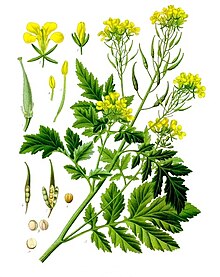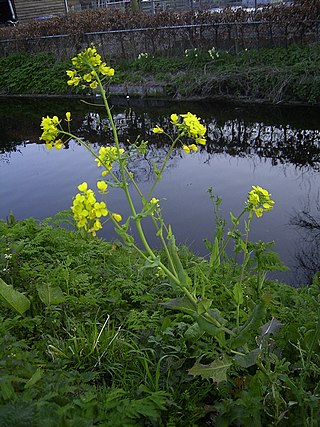
Brassica is a genus of plants in the cabbage and mustard family (Brassicaceae). The members of the genus are informally known as cruciferous vegetables, cabbages, or mustard plants. Crops from this genus are sometimes called cole crops—derived from the Latin caulis, denoting the stem or stalk of a plant.
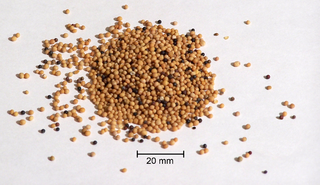
Mustard seeds are the small round seeds of various mustard plants. The seeds are usually about 1 to 2 millimetres in diameter and may be colored from yellowish white to black. They are an important spice in many regional foods and may come from one of three different plants: black mustard, brown mustard, or white mustard.

Rapeseed, also known as oilseed rape, is a bright-yellow flowering member of the family Brassicaceae, cultivated mainly for its oil-rich seed, which naturally contains appreciable amounts of erucic acid. The term "canola" denotes a group of rapeseed cultivars that were bred to have very low levels of erucic acid and which are especially prized for use as human and animal food. Rapeseed is the third-largest source of vegetable oil and the second-largest source of protein meal in the world.

In agriculture, cover crops are plants that are planted to cover the soil rather than for the purpose of being harvested. Cover crops manage soil erosion, soil fertility, soil quality, water, weeds, pests, diseases, biodiversity and wildlife in an agroecosystem—an ecological system managed and shaped by humans. Cover crops can increase microbial activity in the soil, which has a positive effect on nitrogen availability, nitrogen uptake in target crops, and crop yields. Cover crops may be an off-season crop planted after harvesting the cash crop. Cover crops are nurse crops in that they increase the survival of the main crop being harvested, and are often grown over the winter. In the United States, cover cropping may cost as much as $35 per acre.

Rumex crispus, the curly dock, curled dock or yellow dock, is a perennial flowering plant in the family Polygonaceae, native to Europe and Western Asia.
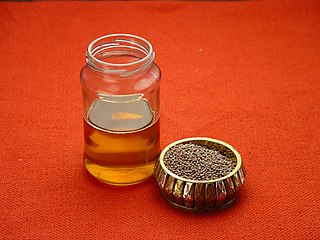
Mustard oil can mean either the pressed oil used for cooking, or a pungent essential oil also known as volatile oil of mustard. The essential oil results from grinding mustard seed, mixing the grounds with water, and isolating the resulting volatile oil by distillation. It can also be produced by dry distillation of the seed. Pressed mustard oil is used as cooking oil in some cultures, but sale is restricted in some countries due to high levels of erucic acid. Varieties of mustard seed also exist that are low in erucic acid.

Safflower is a highly branched, herbaceous, thistle-like annual plant in the family Asteraceae. It is commercially cultivated for vegetable oil extracted from the seeds and was used by the early Spanish colonies along the Rio Grande as a substitute for saffron. Plants are 30 to 150 cm tall with globular flower heads having yellow, orange, or red flowers. Each branch will usually have from one to five flower heads containing 15 to 20 seeds per head. Safflower is native to arid environments having seasonal rain. It grows a deep taproot which enables it to thrive in such environments.

Vicia cracca, is a species of flowering plant in the pea and bean family Fabaceae. It is native to Europe and Asia. It occurs on other continents as an introduced species, including North America, where it is a common weed. It often occurs in disturbed habitats, including old fields and roadside ditches.
Northern root-knot nematode is a species of vegetable pathogens which produces tiny galls on around 550 crop and weed species. They invade root tissue after birth. Females are able to lay up to 1,000 eggs at a time in a large egg mass. By surviving harsh winters, they can survive in cold climates.

Rhamphospermum nigrum, black mustard, is an annual plant cultivated for its dark-brown-to-black seeds, which are commonly used as a spice. It is native to cooler regions of North Africa, temperate regions of Europe, and parts of Asia.

The mustard plant is any one of several plant species in the genera Brassica and Sinapis in the family Brassicaceae. Mustard seed is used as a spice. Grinding and mixing the seeds with water, vinegar, or other liquids creates the yellow condiment known as prepared mustard. The seeds can also be pressed to make mustard oil, and the edible leaves can be eaten as mustard greens. Many vegetables are cultivated varieties of mustard plants; domestication may have begun 6,000 years ago.

Brassica juncea, commonly brown mustard, Chinese mustard, Indian mustard, leaf mustard, Oriental mustard and vegetable mustard, is a species of mustard plant.
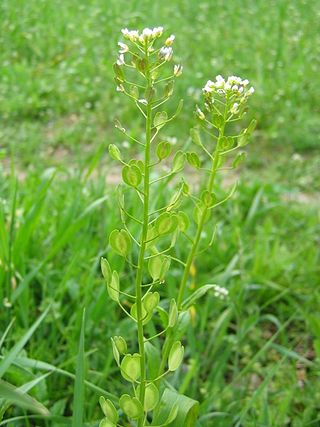
Thlaspi arvense, known by the common name field pennycress, is a flowering plant in the cabbage family Brassicaceae. It is native to Eurasia, and is a common weed throughout much of North America and its home.

Rhamphospermum arvense, the charlock mustard, field mustard, wild mustard, or just charlock, is an annual or winter annual plant in the family Brassicaceae. It is found in the fields of North Africa, Asia, Europe, and some other areas where it has been transported and naturalized. Pieris rapae, the small white butterfly, and Pieris napi, the green veined white butterfly, are significant consumers of charlock during their larval stages.

Rocket, eruca, or arugula is an edible annual plant in the family Brassicaceae used as a leaf vegetable for its fresh, tart, bitter, and peppery flavor. Its other common names include "garden rocket", as well as "colewort", "roquette", "ruchetta", "rucola", "rucoli", and "rugula". E. vesicaria is widely popular as a salad vegetable and it is a species of Eruca native to the Mediterranean region.

Napa cabbage is a type of Chinese cabbage originating near the Beijing region of China that is widely used in East Asian cuisine. Since the 20th century, it has also become a widespread crop in Europe, the Americas and Australia. In much of the world, it is referred to as "Chinese cabbage". In Australia it also is referred to as "wombok".

Diplotaxis tenuifolia is a species of flowering plant in the mustard family known by the common name perennial wall-rocket. It is native to Europe and western Asia, where it grows on disturbed ground and roadsides, and it can now be found throughout much of the temperate world where it has naturalized. In recent years it has increasingly been cultivated to produce salad leaves, which are marketed as wild rocket in Britain or arugula in the US. It is easily confused with garden rocket, which has similar uses.
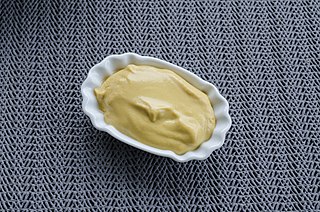
Mustard is a condiment made from the seeds of a mustard plant.
